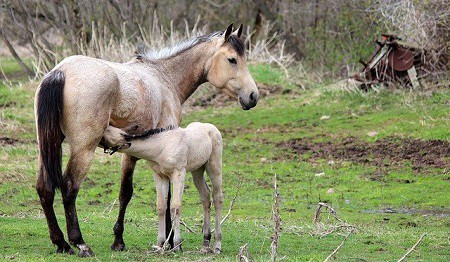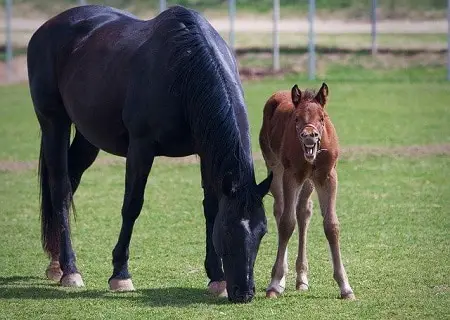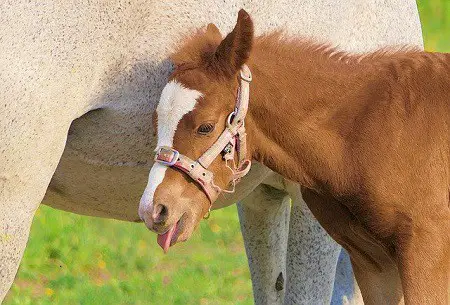Horses are one of the most beautiful animals in nature. A horse’s birth is a remarkable event for any animal lover to witness, and it can be even more exciting when you know what is happening. But there are some common misconceptions about horses that may give people expecting their first foal some anxiety or confusion.
What are baby horses called? First off, baby horses are not called colts or fillies like they would be if they were born as adults. They’re simply called “foals.”
Aside from the fact that a baby horse is called a foal, there are many more things to know about these adorable animals.
What is a Colt?
A colt is a male horse that has not yet reached maturity. They range in age from two to four years old. A filly is a female horse of the same age range.
Colts are usually castrated before puberty, and they may have been given performance-enhancing drugs during their growth period. They are also taller than fillies but smaller than horses because of the hormones they have while growing up.

There are many terms for horses grouped by their age or position in life and weanlings refer specifically to young horses that have recently stopped nursing.
What is the feminine of Colt? The word colt is only used to describe a young male horse. A female of the same age would be called a filly, while you can refer to any equine that’s between one and two years old as a yearling no matter their gender.
If you are a horse owner, it is important to understand the difference between foals and yearlings. Foals typically stop weaning around six months old after which they are called yearlings. A male horse becomes known as a “yearling colt” at one year old but hasn’t reached two years of age yet; meanwhile, females become “yearling fillies“.
When horses turn 2, they’re considered adults – either stallions or mares depending on their sex (male or female). Stallions who have been castrated by removing some reproductive organs continue being referred to as “geldings” rather than males even though they’re not really fully grown stallions anymore!
These rules for naming horses can be confusing for new owners so don’t be ashamed to ask if you need to. A horse is a complex animal, and they have many specific terms that can be used to refer to different types.

A stud is what you call the male horse who is kept to mate with mares or female horses in order to produce foals (baby horses). A broodmare refers specifically to an adult female horse who has been bred for breeding purposes – this type of horse usually produces one foal each year.
Horses mate naturally when out on pastures or wild areas because there isn’t as much control from humans over where exactly things happen, Domesticated horses, however, are carefully chosen for the mating process to happen.
Is a Colt a Horse or a Donkey?
The words “colt” and “horse” are often used interchangeably, but there is a distinction. A colt is a young male horse that has not yet grown to its full size or matured sexually.
Often, the term colt denotes an uncastrated male horse, pony, or donkey. People often mistake it to be the female version of these animals because its pronunciation can rhyme with “bolt” which could make someone think this animal was gender neutral but in reality, they are not.

When referring to baby farm horses from birth until four years old, people also use the word foal so as not to misidentify them for their mother’s counterpart if she were a mare.
The Correct Terminology – Horse Gender & Age
| Term | Description |
| Colt | A male horse or pony that is uncastrated and 4 years or younger. These horses have often not been used for breeding. |
| Filly | A filly is a type of female horse or pony that’s 4 years old but can be as young as 5 in some racing associations. |
| Foal | A foal is a horse that has not yet reached the age of 1. They are either male or female, and they come in two different varieties: colts and fillies! |
| Weanling | A weanling is a foal that has been taken from the mother and no longer drinks her milk. The weaning process typically begins between half a year and to one-year-old, although it varies depending on the weight of the animal. Males are known as “Weanling Colts” while females are called “Weanling Fillies” |
| Yearling | A yearling is a horse or pony of either gender that has just turned 1. A female yearling will be called a “Yearling Filly” and male horses not yet castrated are known as “Yearlings Colts”. |
| Stallion | A stallion is a horse that has reached sexual maturity, but has not yet been gelded (castrated). They can be any color and come in many different shapes and sizes! |
| Gelding | A gelding is a neutered horse that has been castrated and gone through puberty. |
| Rig | A Ridgling is a horse that was born with only a single of their pair of family jewels or both not descended. This makes them look like geldings, but they act as stallions because the testosterone in their body keeps pumping and driving them to be dominant over all other horses on the ranch. |
| Mare | A mare is a female horse that is 4 years or older. Mares tend to be more docile than stallions and they are often considered easier for beginners to handle. |
| Stud | A stud is a male horse that is a stallion or uncastrated male horse. This is a quality horse that is used for breeding purposes. |
| Broodmare | A broodmare is a female horse that can be used for breeding purposes as long as she’s 3 years old or older. The horse’s age must be at least 3 before it can become a broodmare, but the minimum age requirement varies among breeders depending on what they’re looking for in certain qualities of offspring such as size. |
| Sire | Sire is a male horse and is the term used for the father of an offspring or foal. |
| Dam | A dam is a female horse. She is the mother of an offspring or foal, and she produces milk to feed her young. |
| Aged | An aged horse is either gender that has reached the age of 15. An Aged Mare, which can refer to a female, will be called this if they are over 15 years old while an Aged Gelding (or Stallion for those who have been castrated) would only apply when referring to males and it must be at least 15 in order for them to earn the title. |

